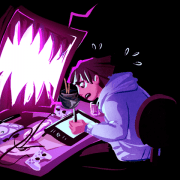When you play video games, character design is only one of the dozens of different aspects that shape your experience. But it’s safe to say that the impact of this one aspect can be more significant compared to the others, especially in narrative-driven games. Character design determines how the player connects to the game, and it shapes the overall experience to the point that the player would likely remember the characters the most long after they are done with the game.
Apart from the player’s impression, characters are usually the essential aspect of the game’s marketing. It is the characters that adorn the cover, the trailers, the Youtube thumbnails, etc. So designing a character that immediately connects with the player – even without any narrative context – is of utmost importance. Potential customers are exposed to the general design of characters more than any other aspect of the game.
Character art can take many shapes and forms depending on the overall style of the game.
- Realistic, like The Last of Us
- Cartoony, like the Borderlands series
- Gritty, like Prince of Persia: Warrior Within
- Ethereal, like Dark Souls Series
- Stylish, like Bioshock Series
Another aspect that can influence character design is animation. Things like the way a character moves and interacts with the world can greatly influence the emotional response of the player to the game. Take Leon S. Kennedy from Resident Evil Franchise as an example.
In Resident Evil 2, his movement is subject to the infamous “Tank Controls” of the series, walking, aiming, and turning around slowly and awkwardly. In Resident Evil 4, his movement is much more fluid and he executes flashy fatalities and acrobatic jumps every now and then. Even if these two games had the same graphics, Leon would be a different character in each one of them just because of the way he moves. In Resident Evil 2, he’s a scared cop who’s in a horrific situation way over his head. In Resident Evil 4, he’s a cool badass special agent who you can rely on.
As 3D graphics advance, 3D character production becomes more diverse and provides more opportunities for expressing and creating different tones and styles. Take the Last of Us and Bioshock Infinite as Examples. Both games were released in 2013, both have a female side character that the player is supposed to like, and both have a main character voiced by Troy Baker (he was on a roll that year, wasn’t he?) who acts like a father figure to these female side characters.

Both Elizabeth from Bioshock Infinite and Ellie from Last of Us have thematic similarities to one another but their character design immediately creates different impressions and assumptions that perfectly match the tone and style of their respective games.
Ellie comes from a ravaged world with a very real sense of tragedy lurking behind its standard apocalyptic setting. She is designed to look and act like a real teenager. Her face is filled with scars, her hair is messy and her clothes are dirty. Everything about her appearance is designed to provoke your sense of empathy and familiarity.
On the other hand, Elizabeth belongs to a fantastical, idealistic setting. Columbia, the city in the sky that she was raised in, is dreamlike and she’s a manifestation of that. Everything about her appearance has a touch of idealism to it. From her beauty to the expressiveness of her face to the ornaments and details on her dress that indicate she comes from a privileged background. Elizabeth is supposed to inspire a sense of wonder and otherworldliness in the player, a sense that will tie neatly with the narrative in the second half of the game.
Despite how similar the overall function of Elizabeth and Ellie is (a young female sidekick that you grow to feel a sense of fatherly protectiveness for), their character design conveys a different feeling altogether, a feeling that ties neatly to the overall style and tone of the game. If these characters were designed in any other way, the negative impact they would have on the game – in terms of making the player feel disconnected from the world – would be unimaginable.

That’s why when designing 3D characters, it’s very important to pay attention to details like these. There are a lot of games out there with serviceable 3D character designs, but only the great ones create 3D characters that fit all the other aspects of the game and elevate the experience from good to great.
For any character artist out there, it’s almost scary to think how much the success of the game could depend on their character design and character art. This is why it’s so important for the game director to give clear and deep insight to the character artist about the thematic function and the emotional purpose of the character they design. Giving commands like “make it cool”, “make it badass” or “make it cute” might result in the creation of a serviceable character, but not a memorable one. Character design can deeply influence the player’s emotional experience of the game, especially in a narrative-driven one, so it’s only fair to invest in it as much as it has the potential to elevate the player’s experience, which is a lot.
Published on:






















دیدگاه خود را ثبت کنید